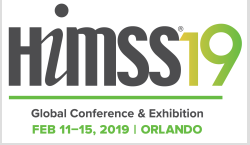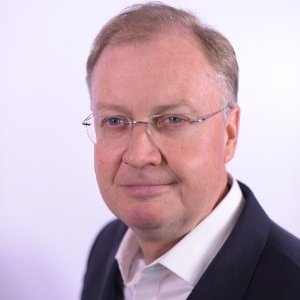Tomaz Gornik
See the following -
Open Health Guide to HIMSS19
 The annual gargantuan HIMSS conference is back in Orlando with over 45,000 participants from more than 90 countries. There will be more than 1,300 vendors at the exhibit floor and more than 300 educational sessions. As with the last several conferences, the focus on open source as the key underlying technologies of health information technologies continues to increase. In previous conferences, we have seen the rise of open source technologies, in particular, those related to interoperability such as FHIR and Blockchain. A large number of sessions at HIMSS19 will be focused on another set of technologies powered largely by open source software and design principles such as artificial intelligence (AI), machine learning, and natural language processing.
The annual gargantuan HIMSS conference is back in Orlando with over 45,000 participants from more than 90 countries. There will be more than 1,300 vendors at the exhibit floor and more than 300 educational sessions. As with the last several conferences, the focus on open source as the key underlying technologies of health information technologies continues to increase. In previous conferences, we have seen the rise of open source technologies, in particular, those related to interoperability such as FHIR and Blockchain. A large number of sessions at HIMSS19 will be focused on another set of technologies powered largely by open source software and design principles such as artificial intelligence (AI), machine learning, and natural language processing.
- The Future Is Open
- Login to post comments
OSEHRA 2016: Marand to present on Postmodern EHRs at Open Source Summit
 Tomaž Gornik, CEO of Marand, will speak at OSEHRA Open Source Summit in Washington DC, the largest annual event in open source health-technologies in the USA. Openness and agility are at the core of Postmodern EHRs. The term “Postmodern” was launched recently by Gartner when describing the ongoing evolution of ERP systems moving from monolithic towards modular systems. Tomaž Gornik applied this concept to EHRs in a series of blog posts and recent presentations at different events around the globe (see blog posts, list of events).
Tomaž Gornik, CEO of Marand, will speak at OSEHRA Open Source Summit in Washington DC, the largest annual event in open source health-technologies in the USA. Openness and agility are at the core of Postmodern EHRs. The term “Postmodern” was launched recently by Gartner when describing the ongoing evolution of ERP systems moving from monolithic towards modular systems. Tomaž Gornik applied this concept to EHRs in a series of blog posts and recent presentations at different events around the globe (see blog posts, list of events).
- Login to post comments
The Postmodern EHR: What are the Enablers?
 Traditional monolithic EHR architectures focus on stability and standardization at the expense of agility. Along with innovation, cloud based deployment and integration of things, agility is the main differentiator when describing the requirements of application architecture for the Postmodern EHR. Achieving agility is impossible for the vast majority of healthcare applications today as they are an inseparable mix of code for user interface, decision logic, workflows and data definitions. New architectures promote agility and reuse by turning the applications inside out and layering the four types of programming into portals, rule engines, process engines and XML data. Let’s look at some examples, layer by layer:
Traditional monolithic EHR architectures focus on stability and standardization at the expense of agility. Along with innovation, cloud based deployment and integration of things, agility is the main differentiator when describing the requirements of application architecture for the Postmodern EHR. Achieving agility is impossible for the vast majority of healthcare applications today as they are an inseparable mix of code for user interface, decision logic, workflows and data definitions. New architectures promote agility and reuse by turning the applications inside out and layering the four types of programming into portals, rule engines, process engines and XML data. Let’s look at some examples, layer by layer:
- Login to post comments
The Postmodern EHR: The Data Layer
 This second approach entails defining a data layer, which is the most important aspect of the Postmodern EHR architecture from my previous post. Why is this the most important layer? Most healthcare organizations are beginning to realize that their data is more valuable than their applications. Data has become a key asset, since good data is key to improving outcomes, managing chronic disease and enabling population health management. And it needs to be managed for the lifetime of the patient. Which application is going to last that long? What happens to health data when we switch applications?
This second approach entails defining a data layer, which is the most important aspect of the Postmodern EHR architecture from my previous post. Why is this the most important layer? Most healthcare organizations are beginning to realize that their data is more valuable than their applications. Data has become a key asset, since good data is key to improving outcomes, managing chronic disease and enabling population health management. And it needs to be managed for the lifetime of the patient. Which application is going to last that long? What happens to health data when we switch applications?
- Login to post comments
The Postmodern EHR: What can Health IT Learn from the Evolution of the ERP Market?
 It seems the pattern is clear. From best of breed to integrated (mega)suite to a new world of innovative, agile, mostly cloud based and multivendor solutions. This is what Gartner calls “Postmodern”. According to Christensen, disruption like this becomes possible when the established players start exceeding the requirements and expectations of their customers, providing only sustaining innovation – i.e. adding more and more features to their products. This is what was happening in the personal productivity space with the Office products. Similarly, the ERP market today has well defined requirements and this allows the newcomers to disrupt, meeting the base expectations and adding innovation and agility while lowering costs.
It seems the pattern is clear. From best of breed to integrated (mega)suite to a new world of innovative, agile, mostly cloud based and multivendor solutions. This is what Gartner calls “Postmodern”. According to Christensen, disruption like this becomes possible when the established players start exceeding the requirements and expectations of their customers, providing only sustaining innovation – i.e. adding more and more features to their products. This is what was happening in the personal productivity space with the Office products. Similarly, the ERP market today has well defined requirements and this allows the newcomers to disrupt, meeting the base expectations and adding innovation and agility while lowering costs.
- Login to post comments
Think!EHR Platform™ chosen by Hospital Sírio-Libanês, a top Brazilian healthcare provider
 Marand has signed a contract with Hospital Sírio-Libanês, one of the premier healthcare institutions in South America. Hospital Sírio-Libanês will use Think!EHR Platform™ as a vendor-neutral structured data repository as well as a foundation for the development of a suite of new clinical applications. Marand will also provide services including consulting, training and support. “Hospital Sírio-Libanês is already a HIMSS EMRAM Stage 6 hospital but in order to reach Stage 7, we have to provide additional clinical functionality in several areas. For this reason, we needed a solution to centralize and integrate all the clinical information in a vendor-neutral structured data repository, analogous to our PACS.
Marand has signed a contract with Hospital Sírio-Libanês, one of the premier healthcare institutions in South America. Hospital Sírio-Libanês will use Think!EHR Platform™ as a vendor-neutral structured data repository as well as a foundation for the development of a suite of new clinical applications. Marand will also provide services including consulting, training and support. “Hospital Sírio-Libanês is already a HIMSS EMRAM Stage 6 hospital but in order to reach Stage 7, we have to provide additional clinical functionality in several areas. For this reason, we needed a solution to centralize and integrate all the clinical information in a vendor-neutral structured data repository, analogous to our PACS.
- Login to post comments
OSEHRA 2016 Open Source Summit
Looking to gain expertise in both public and private sector open source health IT? Want to collaborate on global state-of-the-art solutions for electronic health records, and population health tool development? Need access to domestic and international market opportunities? Then OSEHRA’s 5th annual Open Source Summit, held just outside of Washington, DC from June 27-29, 2016, is the place for you. Nearly 400 industry leaders, federal and state government officials, academics, clinicians, developers, and researchers participated in the 2015 OSEHRA Open Source Summit—with representation from the United States, Canada, India, Jordan, Mexico, Romania, South Korea, and the United Kingdom. Do not miss your opportunity to join them this year!
- Login to post comments
OpenEHR Day
Over the past years, openEHR solutions with a multivendor environment built on an open and agile architecture have proven to be a successful approach to managing electronic healthcare records at any scale. There are several use cases with a focus on electronic health records (EHR) and related systems, validating the vendor-neutral data concept, where universal interoperability among all forms of electronic health data is ensured.To discuss these topics and present successful use cases, you are kindly invited to the 2019 openEHR day being organized by the openEHR Foundation in collaboration with Better and other partners. The event will take place on Monday, October 28, 2019, at SkillsMatter London, United Kingdom. Read More »
- Login to post comments
openEHR 2020 - International Community Event
Hosted by Digital Health and taking place on 24 November, 9am - 5pm (GMT), join us to discover the latest developments, insights and best practice openEHR case studies from a variety of international digital health leaders, including renowned speakers such as Robert Wachter, MD, University of California, San Francisco Department of Medicine Chair and author of The Digital Doctor: Hope, Hype, and Harm at the Dawn of Medicine's Computer Age book, Mike Jones, VP, Gartner Group, CIO Advisory Healthcare, Aloha McBride, EY Global Health Leader, and many more. Read More »
- Login to post comments
openEHR and FHIR – Fiends or Foes? - HIGHmed Symposium 2021
Ever since the COVID-19 pandemic, the need for interoperable and scalable data infrastructures within healthcare has become even more apparent. National and regional governments address these challenges by introducing open platforms, a novel paradigm to enable the data flow required to harness the full potential of big data in medicine. To underline the importance of open platforms, and to provide examples of novel implementations to political stakeholders and the health IT community, we dedicate our this year’s HiGHmed Symposium to openEHR and FHIR, the underlying eHealth standards of the data environment of tomorrow.
- Login to post comments
Global Health Connector Partnership Summit @VIVE
ECHAlliance is delighted to have partnered with ViVE, the Industry's Reimagined Health Information Technology Event and organise our Global Health Connector Partnership (GHCP) on March 9 and starting at 9:30 AM EST. The Global Health Connector Partnership reflects a determined commitment of existing organisations to improve health and care for citizens worldwide through the appropriate use of digital technologies in the provision of health and care services.Under the theme "Data and Digital Services to Support the Recovery of Healthcare Systems Globally" participating organisations of the Global Health Connector Partnership from Africa, Slovenia, Spain, India, Australia, UK and the USA, will be able to pursue solutions to shared problems and discover areas of work via aligned strategic goals for further cost efficiency, reduced risk, and less effort.
- Login to post comments
